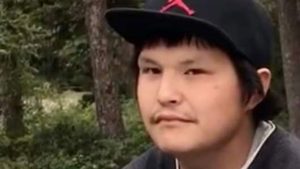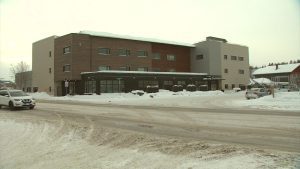John Smarch has fond memories of his nephew, Travis Smarch.
Smarch said Travis, who was a Carcross/Tagish First Nation citizen, was a social and caring person who could easily make others laugh.
“He was always worried about the other guy. Sticking up for people and helping others. He was a good young man when he was alive.”
On Jan. 6, 2022, Smarch was just a block away from the Chilkoot Trail Inn in Whitehorse when he saw several ambulances surrounding the building where his nephew was staying.
“I was telling my wife ‘Oh man, I hope nothing has happened, I hope everything’s okay and stuff,’” he recalls.
Eventually, people informed Smarch his nephew had died from an overdose – alone in an abandoned room. He was 27.
“It’s been hard,” Smarch said. “I know what it’s like. I’ve bought and sold drugs, it’s just a really awful, awful addiction.”

Travis was one of three people from the community of Carcross to die in the first week of January 2022 from a drug overdose, and one of eight people in the territory to die during a three-week span that month from toxic illicit drug use.
In response to the deaths, a year ago, on Jan. 20, 2022, Health and Social Services Minister Tracy-Anne McPhee declared a substance use health emergency on behalf of the territorial government.
The declaration doesn’t grant the government any additional powers or privileges but is a commitment to address the territory’s addictions crisis.
McPhee told APTN News there have been several positives that have happened in the year since the emergency was declared.
“We’ve had a tremendous response with respect our partners. There are many, many programs, (and) enhancements of services that have happened over the last year,” she said.
She noted some initiatives are focused on the Whitehorse Emergency Shelter (WES) where many people with addictions go to stay off the streets and access services.
She said in the last year a mobile paramedic unit has been created. It includes two mobile paramedics and an additional one who focuses on harm reduction.
McPhee said there have been several other service enhancements and initiatives in the last year, including harm reduction education campaigns and increasing and expanding the territory’s drug self-testing capability.
Yukon government also recently launched Car 867, a mobile crisis unit that includes a Mountie, and a mental health nurse. They provide trauma-informed care to people experiencing mental health emergencies.
McPhee said other initiatives include renovating the territory’s supervised consumption site to include an inhalation hood for people who smoke substances.
Government data shows almost 2,000 people used the site in 2022, up from 77 people in 2021.
“(The hood) has increased the individuals who go there to use drugs,” she said. “It’s an opportunity for people to use drugs in a safe way and the inhalation hood has increased the number of people who go there.”
McPhee said the territorial government is committed to tackling the addictions crisis.
“(We’re) trying to find ways to connect and reach out to people who use drugs and provide safe spaces for them to use and access services,” she said.
“In addition to it being a call to action, we can’t solve problems or work on problems unless we name them, unless we give it a voice, unless we say it’s not something we’re willing to accept in our society, in our community.”
‘Just blanks words’
But Smarch isn’t so sure the declaration is doing much to curb the addictions crisis.
A recovering alcoholic himself, he’s concerned too many people are dying despite the initiatives.
According to a December 2022 Yukon Coroners Service report, 25 people died in the territory in 2022 from toxic illicit drug use.
“I’ve lost so many friends in the past year, through alcohol and drugs. For me, it’s just like we’re not doing enough yet. We need more people on the ground, going all over and checking on people,” he said.
Smarch isn’t alone.
Karen Nicloux, who is a member of the Na-Cho Nyäk Dun First Nation, also isn’t convinced enough is being done to address the crisis.
A recovering addict and alcoholic, Nicloux works with unsheltered people at the WES.
In October 2022, the Council of Yukon First Nations and non-profit organization Connective took over control of the shelter from Yukon government, though it continues to provide money to operate.
As the shelter is low barrier, Nicloux feels the territorial government was too tolerant of drug and alcohol use on shelter grounds which has continued since the change of management.
Government spokesperson Mairi Macrae said in an email three deaths have occurred at the shelter between January 2019 and October 2022.
Nicloux said she knows of many more people associated with the shelter that have died over the years.
“This substance use emergency, to me, it’s just words. Just blanks words,” Nicloux said. “I don’t know what they’re saving. They’re only reacting.”
Nicloux said she would like to see the shelter become medium barrier and more restrictions placed on people who use the site.
“There’s no consequences for people’s actions. There’s drug use, drug dealing and overdose. They need to stop the alcohol consumption in and around the building and drug use, period,” she said.
Liz Vick, Connective’s vice president of strategy, said as a low barrier facility, the shelter’s goal is to meet people where they’re at and that anyone is welcome to stay there.
“While the intention of the shelter is primarily to offer people a clean, warm, safe place to sleep, bathe and eat, it also provides access to services that people may want or need in order to address issues they are experiencing such as mental health, addictions or housing assistance,” she said in an email.
But Nicloux disagrees.
“The government says they’re meeting them where they’re at. No, they’re not. They’re keeping them where they’re at,” she said.
Despite the statistics provided by the government regarding increased visits to the supervised consumption site, Nicloux is skeptical it’s making a difference.
She said the people she works with have told her the site isn’t being used as much as it could be by precariously housed people that use the shelter.
She’s also heard the site is increasingly being used by people who don’t frequent the shelter.
Nicloux is concerned about increasing reports of people in active addiction using the shelter as a place to overdose, something she feels it’s not intended for.
While Nicloux said there is a separate floor for people who don’t use substances or are trying to get sober, she’s still concerned the building isn’t safe.
She would like to see people in active addiction using the supervised consumption site as opposed to the shelter so people can feel safe staying there.
“Why aren’t they going over there with shelter staff and management and mandating them to leave the premises? (They should) go over to (the supervised consumption site) where it’s safe to use and be warm, and if you overdose they have everything there,” she said.
Vick said the WES doesn’t encourage or support drug use and that shelter staff follow procedures to prevent drug use on the premises.
“Our goal is to ensure the safety and security of all shelter users and building residents. However, it would be contrary to our low barrier approach and against our goal to provide everyone access to shelter services to create an environment where personal drug use would be impossible,” she said.
“While we do not turn a blind eye nor do we condone drug use, we are not naive that it may happen while we do what we can to prevent it.”
Smarch said he has friends the stay at the shelter and is aware of the problems there, but is hopeful the change in management will be an improvement for the people who use it.
“I do think there is people that are trying and who are trying to get the programming out to people, the people who need it,” he said.
“I think it can be good if we can try to get them, even when they’re in their drug use and stuff, as long as you can get a little idea in their brain, the will to start, to change their life.”

‘Accepting them where they’re at’
McPhee said the supervised consumption site and increased supports at the shelter are saving people from overdose. She said 14 people were saved from overdosing at the supervised consumption site in the last year.
She said the supports have decreased the number of calls to the RCMP and hospital.
“The entire impact has to be looked at together. One life is too many. Individuals make choices that we sometimes can’t always intervene with, but our job is to make sure we have an option every time that happens to not have that be the result,” she said.
McPhee said despite the criticisms people may have, the government is dedicated to tackling the addictions crisis and offering services and support to the people who need them.
“I think the numbers indicate that there has been a positive change. Is it enough? No. Will it ever be enough? Probably not. But we will continue to work on it, work on it with our partners.”
Going forward, Nicloux said she would like to see increased aftercare and the creation of safe spaces in all Yukon communities where people who use substances can go without the fear of judgement.
“You got to kill them with kindness. You got to love them until you can’t anymore,” she said.
As for Smarch, he’s a believer in on-the-land healing. He said he was able to maintain sobriety thanks to the Jackson Lake Healing Camp, a land-based healing camp operated by the Kwanlin Dün First Nation.
McPhee said Yukon government is increasing on-the-land-treatment options, like working with the Teslin Tlingit Council to develop a co-facilitated land-based healing option and partnering with Liard First Nation to develop a cultural program in partnership.
“Treatment can be a foreign place,” Smarch said. “Simply sitting by a fire in the bush can be healing. It soothes the inside of you, it calms you.”
Smarch said he hopes by sharing his nephew’s story others will be inspired to reach out for help if they need it.
“I’m always hoping and praying we can do a lot more for our people, for others who are struggling.”









